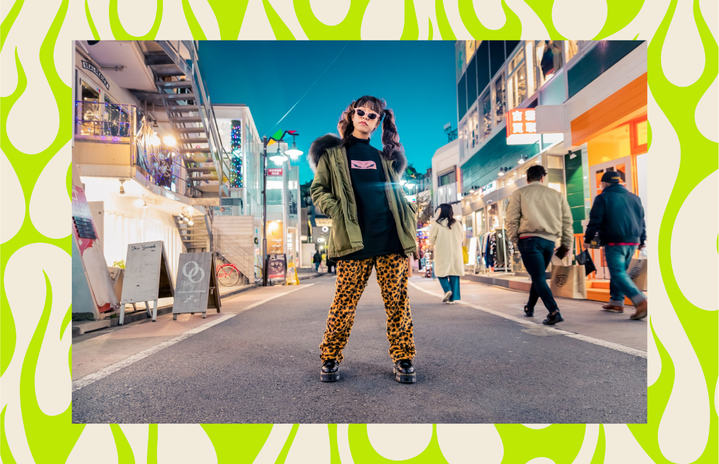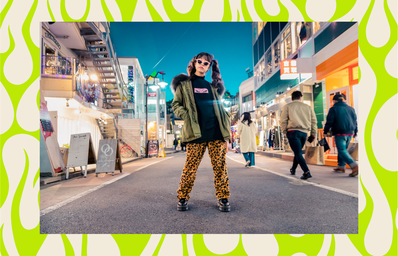American fashion wouldn’t be what it is today without the influence of revolutionary style trends from other cultures: Jeans, an American staple, have origins in Europe, ponchos come from South America, the corsets that make up our beloved Regencycore trend are inspired by the French women of the 15th century, and high necklines have roots in African culture. In light of AAPI Heritage Month, it’s important to acknowledge the attribution of Japanese designers and the Japanese fashion trends that inspired the American streetwear of today.
Japanese fashion is easily recognizable due to its uniqueness, heritage, and culture. Traditional pieces like kimonos are part of Japanese history, but are still present in today’s fashion. The kimono has been a part of Japanese culture and everyday fashion since the Heian Period (794 to 1185). During the Heian period, the women would play with different colors and patterns to create beautiful versions of the kimonos; the different combinations reflected virtues, social status, and personality traits. What once was everyday wear that reflected social status became a symbol of luxe up until the 21st century when they started to come back into mainstream fashion — kimonos were being worn for celebrations, festivals, and traditions.
The intricate designs and silhouettes of kimonos inspired Western fashion both on the runways and in streetwear. For example, Thom Browne showcased men’s suits with kimono-inspired patterns in his summer 2016 fashion show, and typical streetwear pieces, such as jackets, take on reinterpreted kimono styles.
The “De-construction Movement,” inspired by Kawakubo’s avant-garde designs, challenged traditional female silhouettes and blurred the lines of male and female clothing.
In the 1950s, after years of Western culture being a dominating force of the fashion world, Japan started making its mark in the industry by curating pieces that preserved the nation’s historical culture while integrating contemporary aspects, such as using traditional Japanese prints while mixing and matching colors. Japan started becoming the influencer rather than the influenced by reinventing the popular Western fashion trends and giving their own spin on the styles.
In the years to come, we saw Japanese influence all over the world. For example, Japanese designer Rei Kawakubo brought avant-garde masculine designs to women’s fashion in the late 1980s, which we see in her exaggerated silhouettes of jackets and dresses of the time that concealed the female figure rather than making it the main focal point for the male gaze.
The androgynous fashion and asymmetrical designs made their way to America via designers like Rei Kawakubo and Issey Miyake in the ’80s and ’90s, and sparked a fashion movement that put Japanese fashion in the spotlight of Western fashion. The “De-construction Movement” of fashion in the ’80s, inspired by Kawakubo’s avant-garde designs, challenged traditional female silhouettes and blurred the lines of male and female clothing on runways in Paris. These simplistic yet unconventional designs inspired fashion powerhouses, such as Alexander McQueen and John Galliano. The androgynous designs are seen in American streetwear today with oversized suits and asymmetrical pants.
Wabi-Sabi brought an aspect of authenticity to fashion because the philosophy’s three premises are based on embracing imperfections and simplicity.
Pioneered by Japanese designers that embraced unevenness, Wabi-Sabi — the beauty of imperfection — is a Japanese philosophy that is seen in modern streetwear. The philosophy brought an aspect of authenticity to fashion because the philosophy’s three premises are based on embracing imperfections and simplicity: Nothing lasts, nothing is finished, and nothing is perfect. This philosophy is seen in contemporary streetwear pieces, such as sweaters with frayed hems or monochromatic outfits.
However, Japan’s influence on street fashion can’t be talked about without appreciating the bright colors and clashing prints of Harajuku streetwear. The Harajuku district is an urban neighborhood in Tokyo where fashion is focused on freedom of creative expression and community. From Lolita to Ko-gyaru and Punk-rock to high-end street fashion, Harajuku style is a cumulation of fashion trends that are lively and quirky yet sophisticated and tasteful. Harajuku is one of many styles that have inspired the bold streetwear trends of 2022, such as bright-colored oversized hoodies, loud-printed shirts, and metallic accents.
The iconic fashion of Japan has inspired American designers, but also allowed Japanese designers and brands to make a name for themselves as individuals. Popular streetwear brands in America first made their mark in Japan, such as BAPE, which was founded in 1993 by Japanese designer NIGO. Japanese designers have had a place in pop culture, such as designer Kansai Yamamoto who has designed costumes that incorporate traditional Japanese designs with bold colors for celebrities like Lady Gaga, David Bowie, and Elton John.
Designers must understand the cultural significance behind the Japanese accents or styles in their pieces.
Not only has the clothing of Japanese designers and streetwear heavily influenced American fashion, aspects of Japanese culture have also found their way into the West. Japonisme, a term coined by the French in the 1870s that is based on using traditional Japanese prints and patterns as art, has made an impact in Western fashion. Patterns, such as cherry blossoms, butterflies, and dragons, are seen on traditional Japanese pieces like kimonos, but are also used by high-end designers in their creations like silk tops.
While the incorporation of Japanese fashion and culture in American streetwear has allowed for appreciation and recognition, it’s important to celebrate the culture without appropriating its history and Japanese traditions. Culture is part of an identity, not a collectible item or some high-end fashion piece. To appreciate the culture in American fashion, designers must understand the cultural significance behind the Japanese accents or styles in their pieces. From jumpsuits to eccentric dresses and jackets, Japanese culture has been a major influence in streetwear fashion and the world; so before celebrating their influence, you should understand the historical significance behind the pieces that have allowed for curation of iconic fashion trends and movements.


